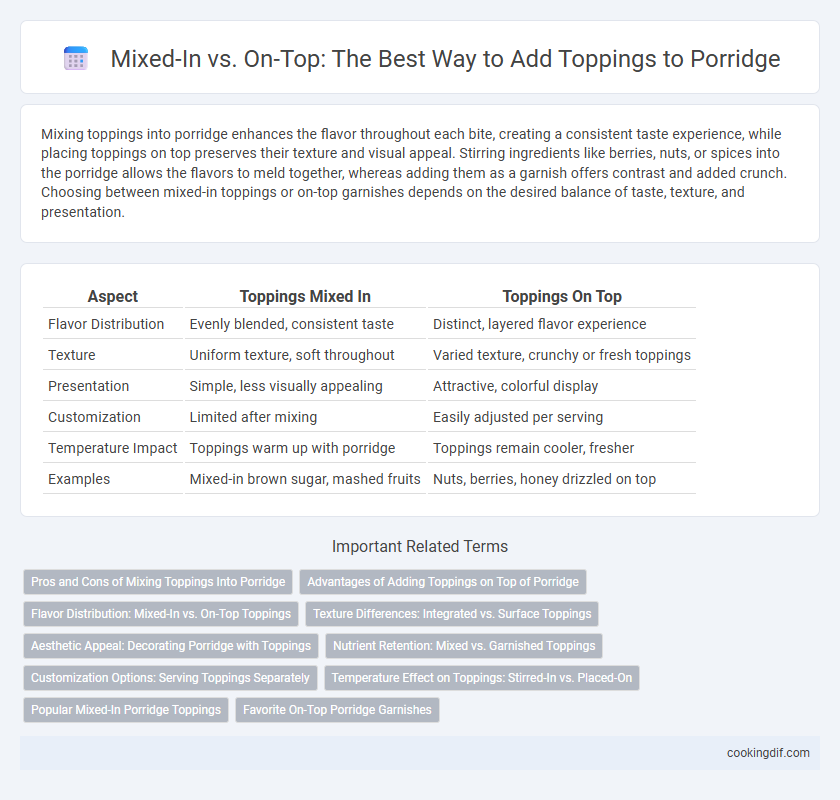Mixing toppings into porridge enhances the flavor throughout each bite, creating a consistent taste experience, while placing toppings on top preserves their texture and visual appeal. Stirring ingredients like berries, nuts, or spices into the porridge allows the flavors to meld together, whereas adding them as a garnish offers contrast and added crunch. Choosing between mixed-in toppings or on-top garnishes depends on the desired balance of taste, texture, and presentation.
Table of Comparison
| Aspect | Toppings Mixed In | Toppings On Top |
|---|---|---|
| Flavor Distribution | Evenly blended, consistent taste | Distinct, layered flavor experience |
| Texture | Uniform texture, soft throughout | Varied texture, crunchy or fresh toppings |
| Presentation | Simple, less visually appealing | Attractive, colorful display |
| Customization | Limited after mixing | Easily adjusted per serving |
| Temperature Impact | Toppings warm up with porridge | Toppings remain cooler, fresher |
| Examples | Mixed-in brown sugar, mashed fruits | Nuts, berries, honey drizzled on top |
Pros and Cons of Mixing Toppings Into Porridge
Mixing toppings into porridge enhances flavor integration, creating a uniform taste experience and ensuring even distribution of nutrients like fiber and antioxidants from fruits or nuts. This method can improve texture by softening ingredients and blending sweetness or saltiness throughout the dish but may result in a loss of distinct textures and visual appeal found with toppings placed on top. Mixing toppings also allows for better heat absorption, warming ingredients evenly, but can diminish the freshness and crunchiness of items like granola or seeds.
Advantages of Adding Toppings on Top of Porridge
Adding toppings on top of porridge allows for customizable texture and flavor in each bite, preserving the creaminess of the base while providing contrast from crunchy nuts or sweet berries. This method prevents sogginess that occurs when toppings are mixed in, maintaining visual appeal and freshness. Serving toppings separately on porridge also enables control over portion sizes and dietary preferences, catering to individual taste and nutritional needs.
Flavor Distribution: Mixed-In vs. On-Top Toppings
In porridge preparation, mixing toppings into the dish ensures even flavor distribution throughout each spoonful, enhancing the overall taste experience. Toppings on top create distinct flavor bursts, allowing customization with each bite but may result in inconsistent taste. Consumers seeking a balanced and integrated flavor typically prefer mixed-in toppings, while those enjoying varied textures opt for toppings served on top.
Texture Differences: Integrated vs. Surface Toppings
Integrating toppings into porridge creates a uniform texture, allowing ingredients like nuts or fruits to soften and blend with the creamy grains, enriching each spoonful consistently. Surface toppings remain distinct, offering a contrasting crunch or burst of flavor that enhances the sensory experience with every bite. Choosing between mixed-in or surface toppings ultimately defines the textural dynamic, influencing the overall enjoyment of the porridge.
Aesthetic Appeal: Decorating Porridge with Toppings
Incorporating toppings mixed into porridge offers a rustic, blended texture that enhances flavor complexity, while placing toppings on top creates a visually appealing presentation with distinct layers and vibrant colors. Surface toppings allow for decorative patterns using fruits, nuts, seeds, or spices, elevating the dish's aesthetic appeal and making it more Instagram-worthy. Opting for toppings on top maximizes visual impact, encouraging an inviting and gourmet appearance that stimulates appetite prior to tasting.
Nutrient Retention: Mixed vs. Garnished Toppings
Mixing toppings into porridge during cooking can enhance nutrient absorption by evenly distributing vitamins and minerals throughout the dish, while some heat-sensitive nutrients may degrade. Garnishing porridge with fresh toppings preserves the integrity of heat-labile nutrients such as vitamin C and certain antioxidants, providing a fresher nutritional profile. Choosing between mixed and garnished toppings depends on desired nutrient retention balanced with flavor and texture preferences.
Customization Options: Serving Toppings Separately
Serving porridge with toppings on top allows for personalized customization, enabling individuals to adjust flavors and textures according to their preferences. Mixing toppings into the porridge offers a uniform taste experience but limits the ability to tailor each bite. Offering toppings separately maximizes versatility, catering to dietary restrictions and varying sweetness or crunch preferences.
Temperature Effect on Toppings: Stirred-In vs. Placed-On
Stirring toppings directly into hot porridge causes ingredients like fruit, nuts, or spices to release their flavors and soften due to increased temperature and moisture exposure. Toppings placed on top retain their original texture and temperature, offering a contrasting sensory experience with a cooler, crunchier bite. The heat transfer differs markedly, influencing taste intensity and mouthfeel depending on whether toppings are mixed in or served on the surface.
Popular Mixed-In Porridge Toppings
Popular mixed-in porridge toppings like chia seeds, mashed bananas, and nut butters enhance texture and nutritional value by blending smoothly into the porridge base. Incorporating ingredients such as cinnamon, flaxseeds, and diced apples during cooking allows flavors to infuse thoroughly, offering a warm, consistent taste throughout the dish. These mixed-in toppings provide a richer, more integrated flavor profile compared to toppings scattered on the surface.
Favorite On-Top Porridge Garnishes
Favorite on-top porridge garnishes such as fresh berries, chopped nuts, and a drizzle of honey provide a burst of flavor and texture contrast that enhances the eating experience. Toppings mixed into porridge tend to blend flavors evenly but can lose the visual appeal and textural variety that distinct garnishes offer. Choosing on-top toppings allows for customization and a visually appealing presentation that stimulates appetite and enjoyment.
Toppings mixed in vs toppings on top for serving porridge Infographic

 cookingdif.com
cookingdif.com